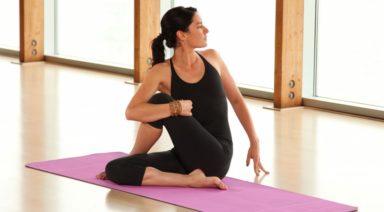Purvottanasana: Reverse Plank Pose

Purvottanasana (PUR-voh-tah-NAH-sah-nah) is a sibling of bridge pose and plank pose. Reverse plank may look intimidating for the shoulders, but there are several variations of the pose, all of which can help open the front of the body while strengthening the back.
Philosophy and Origin:
This pose goes by many names including “reverse plank,” and “upward-facing plank” pose. The Sanskrit name translates to “intense east stretch.” Ancient yogis considered the front of the body to be the “east” side as yoga was practiced while facing the rising sun.
Sanskrit:
- Purva: east
- Ut: intense
- Tan: stretch
- Asana: pose
Physical Benefits:
- Opens the chest and shoulders.
- Builds and tones the core muscles.
- Counters forward-facing tasks like sitting at a desk, driving, and looking at a phone.
Energetic Benefits:
- Releases tension from the body.
- Relieves fatigue and stress.
Preparatory Poses:
- Camel pose | Ustrasana
- Bridge pose | Setu bandhasana
- Plank pose | Phalakasana
Sequential Poses:
- One-legged reverse plank | Eka pada purvottanasana
- Upward-facing bow pose | Urdhva dhanurasana
Counter Poses:
- Half lord of the fishes | Ardha matsyendrasana
- Seated forward fold | Paschimottanasana
- Childs pose | Balasana
Adjustments/Modifications:
- Use a block: Build inner core strength by placing a block in between your thighs, then squeeze the block as you lift into the pose.
- Half reverse plank: Place the soles of your feet on the ground with knees bent for a variation of full reverse plank.
Step-By-Step:
- Begin seated with your legs out in front of you.
- Reach through the ball mounds of your feet, halfway between pointed and flexed.
- Place your hands behind you, fingertips pointing toward your hips. Roll your shoulders behind you.
- Press into your palms and through the ball mounds of your feet. Exhale to lift your hips off the ground, tailbone pointing toward your heels.
- Lift your heart. Option to lift your gaze to the ceiling.
- Hold for five breaths, then release hips to the ground.
###Legal Disclaimer Before participating in any exercise program or using any fitness products or services that may be described and/or made accessible in or through the Gaia Website and/or the Services, you should consult with a physician or other healthcare provider. Read more about Gaia’s Terms Of Use.
Viparita Virabhadrasana: Reverse Warrior Pose

ADJUSTMENTS | BENEFITS | SEQUENCING | SANSKRIT | STEPS
In viparita virabhadrasana (VIP-uh-REE-tuh veer-uh-buh-DRAHS-uh-nuh), experience a member of the “warrior” family with an incredible opening in the side of the torso as well as the stretching the legs. By giving the side of your heart an opportunity to shine (as a side bend rather than a back bend), this posture offers all sorts of positive vibes, including a boost of self-esteem and perseverance.
Philosophy + Origin
The general definition of a warrior is someone who “engages in warfare,” which conjures up images of battlefields, weapons, and violence. The power of reverse warrior is to “turn around” this imagery to think about warriorship in different contexts. The idea of a peaceful warrior, or even a light warrior, is used in yoga to remind students that showing up with love and intention in day-to-day life is just as important, if not more so. When practicing reverse warrior, ask yourself to consider definitions or beliefs in your life from another perspective. There are two sides to each coin, and the better you know both sides, the better prepared you will be to live your life with steadiness, grace, and ease.




































